#Karstmas day 7
-
#Karstmas day 7
Sorry for the delay folks, today was quite busy with a callout with the K9 SAR team. Happy ending!
So this prompted me to write a bit about safety in caving today, in particular with vertical caves (pits). This is quite the famous pit in Alabama, it's on like every top 5 list to visit (best views, best hikes, best waterfalls, best cave...every clickbait list this cave is on). What is unique about it, is that there is a horizontal walk-in entrance as well, where you can get to this view. This is both good...and bad.
When I started caving many moons ago, this cave was privately owned. So only cavers knew about it, and got permission by directly asking to go. Now, it is owned by a cave conservancy, and is much more open to visitation, just requiring a permit which is free and easy to fill out online. This is good - it lets lots of people enjoy this amazing view you think you'd have to travel far away to see. This is also bad - despite having to check off many things when you get the permit, no one *actually reads*, and as a result...well.
See that nice round rock middle bottom? We all call that "The Pedestal". You can climb the rock down to it, the slippery wet rock over a 40+ foot drop. You aren't supposed to free-climb here, but *everyone* does for their Instagram photo.
I'll make this simple: Never be closer than 6 feet (2 meters) from an edge without being tied in to a safety line. If the edge is sloped to the drop-off, that edge starts at the *top of the slope* where if you fell, you could keep rolling. Great rule of thumb for any edge, whether cliff or cave.
In this case, once you are on the Pedestal, you're okay on a section of it. But if you are climbing the rock up to the right, or wanting to go further down, you need to be tied in. People also like to stand at the pit entrance and lean over to look - there's a small tree on the steep slope they hold onto to do so. Yikes!
Guess who has personally been on the team, not once, but TWICE, that has bagged & pulled bodies out of this pit? Yeah. Coroners do not rappel into caves, cave rescue takes the body bag in, documents & photographs, and pull it back out. So, be safe please, around edges. Don't turn yourself into chunky jelly.
It's not worth the photo.
Now this place has a bunch of signs, but, people do stupid shit they aren't supposed to anyway. So I don't go anymore. Not because of the bodies - I have medical background and am not phased doing that stuff - but because I don't want to *watch* people be stupid. It gives me too much anxiety, and ruins my day. Shame, as it really is gorgeous and it used to be an annual summer trip.
So. Be smart. Be safe. Pick living to see more wonderful things over a single moment's photo.
#cave #caves #caving #safety #rescue #recovery #geology #karst #cliff #climbing
-
 D devnull moved this topic from Uncategorized on
D devnull moved this topic from Uncategorized on


